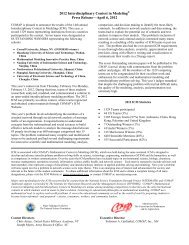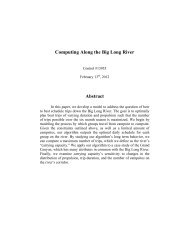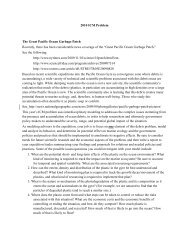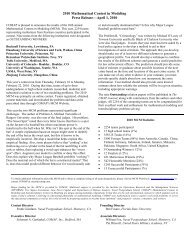Centroids, Clusters and Crime: Anchoring the Geographic Profiles of ...
Centroids, Clusters and Crime: Anchoring the Geographic Profiles of ...
Centroids, Clusters and Crime: Anchoring the Geographic Profiles of ...
You also want an ePaper? Increase the reach of your titles
YUMPU automatically turns print PDFs into web optimized ePapers that Google loves.
Team # 7507 Page 5<br />
techniques on average reduce <strong>the</strong> area to be searched by nearly a factor <strong>of</strong> 10.[2]<br />
By contrast, <strong>the</strong> practice <strong>of</strong> forecasting where a criminal will strike next has not been explored<br />
deeply in quantitative criminology literature[15]. Indeed, predicting where, say, a serial<br />
rapist will strike next may require (in addition to an uncomfortable level <strong>of</strong> clinical detachment<br />
from <strong>the</strong> past victims), a far more complex set <strong>of</strong> inputs, as it is far less clear what information<br />
might inform <strong>the</strong> criminals decision about where to strike.<br />
Naively, one might be tempted to simply generate a heat map <strong>of</strong> rape incidents in <strong>the</strong> rapists<br />
region <strong>of</strong> activity, <strong>and</strong> predict that <strong>the</strong> next strike will occur where <strong>the</strong> most rapes have occurred<br />
before. Clearly, however, this approach essentially discards all previous information about <strong>the</strong><br />
modus oper<strong>and</strong>i <strong>of</strong> <strong>the</strong> criminal in question, whose individual pattern <strong>of</strong> strikes may differ<br />
substantially from <strong>the</strong> aggregate behavior <strong>of</strong> previous rapists. Paulsen <strong>and</strong> Robinson (2009)<br />
also observe that for many departments <strong>the</strong>re are substantial practical, ethical, <strong>and</strong> legal issues<br />
involved in collecting <strong>the</strong> data for a detailed mapping <strong>of</strong> criminal tendencies, with <strong>the</strong> result<br />
that only 16% <strong>of</strong> local police departments in <strong>the</strong> United States employ a computerized mapping<br />
technique.<br />
A more sophisticated technique could map a wide variety <strong>of</strong> variables from lighting levels<br />
or proximity to bars, <strong>and</strong> seek to correlate <strong>the</strong> rapists previous strikes to whichever variables<br />
appear most significant. But this too has its drawbacks, for in this low-statistics environment,<br />
it is not at all clear that a sufficiently strong correlation could be found.<br />
Fur<strong>the</strong>rmore, this method only exacerbates <strong>the</strong> practical problems <strong>of</strong> data collection, potentially<br />
requiring police <strong>of</strong>ficers to trawl <strong>the</strong> streets with clipboards subjectively evaluating<br />
dozens <strong>of</strong> criteria at each city block. While a computer model might indeed produce valuable<br />
output once this encyclopedic compendium <strong>of</strong> data was compiled, we suspect in many cases<br />
that a highly trained <strong>of</strong>ficer who is familiar with <strong>the</strong> ins <strong>and</strong> outs <strong>of</strong> his city could likely intuit<br />
a similar result at a reduced cost. Rossmo (1987), for example, describes <strong>the</strong> case <strong>of</strong> one<br />
Richard Ramirez, who raped or killed 33 individuals in <strong>the</strong> mid-eighties <strong>and</strong> “seemed to target<br />
single-story houses painted in light, pastel colors.” Naturally, all but <strong>the</strong> most egregiously<br />
detailed mapping schemes would fail to identify this pattern computationally, whereas an alert<br />
policeman might well notice it instantly.<br />
Our treatment <strong>of</strong> <strong>the</strong> problem will <strong>the</strong>refore employ an approach more akin to <strong>the</strong> anchor<br />
point finding algorithms described above. By examining experimentally confirmed trends in<br />
<strong>the</strong> relationships between crime locations (<strong>and</strong> between crime locations <strong>and</strong> estimated anchor<br />
points), we generate likelihood surfaces which effectively act as a prioritization scheme for<br />
regions which should be monitored or patrolled more aggressively in hopes <strong>of</strong> intercepting <strong>the</strong><br />
next crime.
















